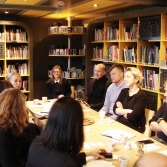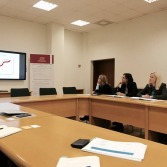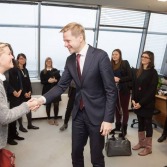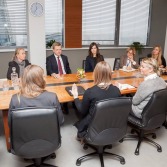The crew of Design for Europe landed in Vilnius and spent 48 h with a noble mission – to spur design-driven innovations in Lithuania. This high-expertise team, that we could definitely call a ‘crew’ because everybody has their own role and works hand in hand for the same goal, made a huge success and helped to identify the main problems that create obstacles for design powered future.
This kick-off visit has helped to open a dialog between representatives from different sectors.
High-level meetings
The first day has started with a meeting of representatives from different institutions of design education. They emphasized few biggest problems: a gap between education and business sector, schools and universities are competing to much with each other and do not have enough time to collect data that reflects the impact of design which could be provided for the Ministry of Education as a proof of importance of design.
Even if there were only 30 min for a meeting at the Mayor’s office, the conversation was very fruitful. The Municipality of Vilnius is working on a new city plan. One of the biggest challenge is how they could improve a better live in areas of the city that are not so attractive for people because of the old Soviet times buildings, logistics and safety level. The Mayor and his team were impressed by some City of Helsinki examples presented by Laura Aalto and stressed the importance of design-driven city where all services should be human centered.
The Ministerial meeting took place at the Ministry of Economy. People from different institutions as Lithuanian Council for Culture, Agency of Science, Innovation and Technology (MITA) were trying to reflect the situation of Design Sector in governmental level.
The seminar “Accelerating Design-driven Innovation in Lithuania”
The second day of the visit was delighted for a seminar that attracted more than 35 attendees from wide range of fields. The conference was hosted in one of the most creative buildings in Vilnius called Arts Printing House. One of rehearsal rooms was transformed into a conference hall. Honestly, the model of the conference was quite new for Lithuanians – round tables covered of papers with some questionnaires, pens and post-it notes were sending a message that people will have to be interactive here. Even if Lithuanians are quite conservative and the barrier of English language skills exists too but Design for Europe team managed to create a positive work environment where people were not afraid to express their opinion based on their own experience, say some critics and propose ideas how we could raise the awareness of design not only in a capital but also in less central areas of Lithuania.
“First of all, as a mother of three sons that represent two different generations and are still growing up, I have a huge interest to have a better education system. Also, my background of international business management helps do not forget that business always should be based on innovations, good sense of marketing pulse and cooperation with schools, colleges and universities. Design could be used as a tool to connect bridges between those sectors. Without cooperation, business won’t be successful, our nation get older, young people emigrate and Lithuania will become just a one country in a map without national identity and future.” – Neila Šveikauskaitė, CEO at “Vilniaus kailiai”
To sum up, the crew of 9 people made a successful invasion into Lithuanian design ecosystem in 48 hours. Result: 1 trip, 3 high-level meetings, 1 seminar, 4 presentations, 5 round tables, 35 attendees and unknown number of new ideas.
Invalid Displayed Gallery
Many thanks for everybody who took some time out of your busy schedules. Lithuanian design forum is full of enthusiasm to develop this cooperation further. We truly understand that it’s very hard to do changes on our own so all new partnerships and initiatives are very welcome. There is a hope that we not only absorbed the experience from Design for Europe international crew but also reflected the current situation in Lithuania that will be more easy to understand for foreign countries. Who knows, maybe together we will be able to develop a legacy programme based on Lithuanian model that could be applied to other not so well known design countries that face similar challenges?





This Post Has 0 Comments